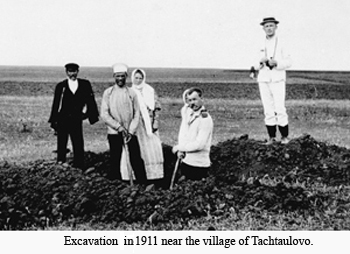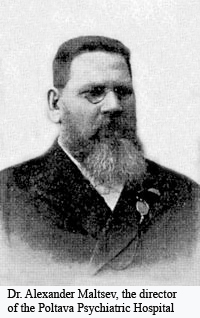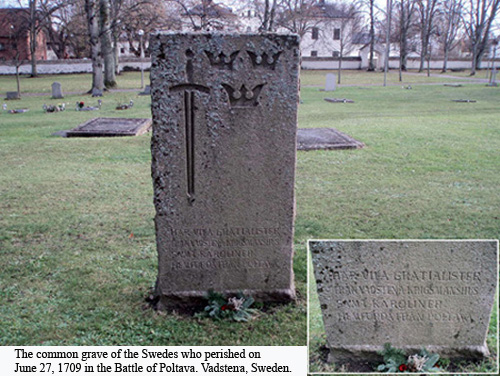|
 In the summer of 1911 Carl Bennedich and Frei Rydeberg, two Swedish lieutenants from the Northern Scania Regiment, visited Poltava. They were sent to Poltava by the General Staff of the Swedish army for the purpose of organizing an archaeological survey of the Poltava Battle field to determine the main burial places of the soldiers of King Charles XII. On the eve of the trip, they received permission from the Ministry of the Interior of the Russian Empire to conduct excavations on the Poltava battle field. Using the appropriate equipment for conducting a topographical survey, Carl Bennedich and Frei Rydeberg prepared a detailed map of the battlefield. In addition they took a large number of photos in Poltava, Perevolochna, Golovchin, and many other places connected with the battles of the Great Northern war.
In the summer of 1911 Carl Bennedich and Frei Rydeberg, two Swedish lieutenants from the Northern Scania Regiment, visited Poltava. They were sent to Poltava by the General Staff of the Swedish army for the purpose of organizing an archaeological survey of the Poltava Battle field to determine the main burial places of the soldiers of King Charles XII. On the eve of the trip, they received permission from the Ministry of the Interior of the Russian Empire to conduct excavations on the Poltava battle field. Using the appropriate equipment for conducting a topographical survey, Carl Bennedich and Frei Rydeberg prepared a detailed map of the battlefield. In addition they took a large number of photos in Poltava, Perevolochna, Golovchin, and many other places connected with the battles of the Great Northern war.
 The excavations, carried out with the active support of Dr. Alexander Maltsev, then the director of the Poltava Psychiatric Hospital, revealed two large burial grounds of soldiers of Karl XII. These locations were marked by Carl Bennedich on the map. Four skulls and several fragments of upper jaws were shipped in a wooden box, lined with lead, and delivered to Stockholm in the autumn of 1911.
The excavations, carried out with the active support of Dr. Alexander Maltsev, then the director of the Poltava Psychiatric Hospital, revealed two large burial grounds of soldiers of Karl XII. These locations were marked by Carl Bennedich on the map. Four skulls and several fragments of upper jaws were shipped in a wooden box, lined with lead, and delivered to Stockholm in the autumn of 1911.
For a long time the box was kept in a separate room in the Department of Military History, a division of the Ministry of Defense of Sweden. In January 1951, 40 years after the arrival of the box in Stockholm, a joint commission of the Ministry of Defense and the Museum of the Swedish Army in Stockholm decided to open the box. The commission recorded the content of the box, which included the remains of several soldiers, a handwritten report on the search for the main burial places of the warriors of Charles XII on Poltava battle field, signed on March 30, 1912 by Carl Bennedich and Frey Rydeberg, five maps of Poltava battle field, and four dried roses. The findings were handed over for anthropological and medical-anatomical research to a famous Swedish anthropologist, Dr. Nils-Gustav Eivall. The results of the study were published in 1957 in the annual proceedings of the Society of Friends of the Museum of the Swedish Army.
 After the examination of the remains of the Swedish warriors brought back from Poltava, the question of finding an appropriate place for their burial had to be addressed. This time the decision was made fairly quickly. The commission members chose the St. Birgitta convent, founded in Vadstena in the middle of the XIV century, and located close to the Veterans’ Home, where former soldiers who were injured in battle and left without the means to support themselves, were provided a home and care by the state.
After the examination of the remains of the Swedish warriors brought back from Poltava, the question of finding an appropriate place for their burial had to be addressed. This time the decision was made fairly quickly. The commission members chose the St. Birgitta convent, founded in Vadstena in the middle of the XIV century, and located close to the Veterans’ Home, where former soldiers who were injured in battle and left without the means to support themselves, were provided a home and care by the state.
 It was here, in the convent cemetery, that the remains of the soldiers of Charles XII, brought home in 1911 from the Poltava battle field, were buried on June 12, 1958 with full military honours. A stone with the inscription “Here rest the retirees from Vadstena Veteran’s Home and the warriors of Charles XII brought home from Poltava” was installed on the grave. Thus, the only common grave of the Swedes who perished on June 27, 1709 in the Battle of Poltava is located now more than 2,000 kilometers from Poltava.
It was here, in the convent cemetery, that the remains of the soldiers of Charles XII, brought home in 1911 from the Poltava battle field, were buried on June 12, 1958 with full military honours. A stone with the inscription “Here rest the retirees from Vadstena Veteran’s Home and the warriors of Charles XII brought home from Poltava” was installed on the grave. Thus, the only common grave of the Swedes who perished on June 27, 1709 in the Battle of Poltava is located now more than 2,000 kilometers from Poltava.
|
 History
History
 Dates and events
Dates and events
 Persons
Persons
 Poltava
Poltava
 Sights
Sights
 Photo gallery
Photo gallery
 Maps
Maps
 Virtual Museum
Virtual Museum
 Armament
Armament
 Uniforms
Uniforms
 Coins and medals
Coins and medals
 Flags
Flags
 Paintings
Paintings
 Poltava photographs
Poltava photographs
 News
News
 About us
About us
 Acknowledgments
Acknowledgments
 Main page
Main page
 Photo gallery
Photo gallery
 top
top ...back
...back  In the summer of 1911 Carl Bennedich and Frei Rydeberg, two Swedish lieutenants from the Northern Scania Regiment, visited Poltava. They were sent to Poltava by the General Staff of the Swedish army for the purpose of organizing an archaeological survey of the Poltava Battle field to determine the main burial places of the soldiers of King Charles XII. On the eve of the trip, they received permission from the Ministry of the Interior of the Russian Empire to conduct excavations on the Poltava battle field. Using the appropriate equipment for conducting a topographical survey, Carl Bennedich and Frei Rydeberg prepared a detailed map of the battlefield. In addition they took a large number of photos in Poltava, Perevolochna, Golovchin, and many other places connected with the battles of the Great Northern war.
In the summer of 1911 Carl Bennedich and Frei Rydeberg, two Swedish lieutenants from the Northern Scania Regiment, visited Poltava. They were sent to Poltava by the General Staff of the Swedish army for the purpose of organizing an archaeological survey of the Poltava Battle field to determine the main burial places of the soldiers of King Charles XII. On the eve of the trip, they received permission from the Ministry of the Interior of the Russian Empire to conduct excavations on the Poltava battle field. Using the appropriate equipment for conducting a topographical survey, Carl Bennedich and Frei Rydeberg prepared a detailed map of the battlefield. In addition they took a large number of photos in Poltava, Perevolochna, Golovchin, and many other places connected with the battles of the Great Northern war.
 The excavations, carried out with the active support of Dr. Alexander Maltsev, then the director of the Poltava Psychiatric Hospital, revealed two large burial grounds of soldiers of Karl XII. These locations were marked by Carl Bennedich on the map. Four skulls and several fragments of upper jaws were shipped in a wooden box, lined with lead, and delivered to Stockholm in the autumn of 1911.
The excavations, carried out with the active support of Dr. Alexander Maltsev, then the director of the Poltava Psychiatric Hospital, revealed two large burial grounds of soldiers of Karl XII. These locations were marked by Carl Bennedich on the map. Four skulls and several fragments of upper jaws were shipped in a wooden box, lined with lead, and delivered to Stockholm in the autumn of 1911. After the examination of the remains of the Swedish warriors brought back from Poltava, the question of finding an appropriate place for their burial had to be addressed. This time the decision was made fairly quickly. The commission members chose the St. Birgitta convent, founded in Vadstena in the middle of the XIV century, and located close to the Veterans’ Home, where former soldiers who were injured in battle and left without the means to support themselves, were provided a home and care by the state.
After the examination of the remains of the Swedish warriors brought back from Poltava, the question of finding an appropriate place for their burial had to be addressed. This time the decision was made fairly quickly. The commission members chose the St. Birgitta convent, founded in Vadstena in the middle of the XIV century, and located close to the Veterans’ Home, where former soldiers who were injured in battle and left without the means to support themselves, were provided a home and care by the state.
 It was here, in the convent cemetery, that the remains of the soldiers of Charles XII, brought home in 1911 from the Poltava battle field, were buried on June 12, 1958 with full military honours. A stone with the inscription “Here rest the retirees from Vadstena Veteran’s Home and the warriors of Charles XII brought home from Poltava” was installed on the grave. Thus, the only common grave of the Swedes who perished on June 27, 1709 in the Battle of Poltava is located now more than 2,000 kilometers from Poltava.
It was here, in the convent cemetery, that the remains of the soldiers of Charles XII, brought home in 1911 from the Poltava battle field, were buried on June 12, 1958 with full military honours. A stone with the inscription “Here rest the retirees from Vadstena Veteran’s Home and the warriors of Charles XII brought home from Poltava” was installed on the grave. Thus, the only common grave of the Swedes who perished on June 27, 1709 in the Battle of Poltava is located now more than 2,000 kilometers from Poltava.